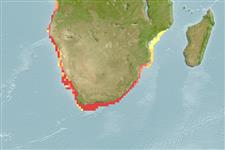Environment: milieu / climate zone / depth range / distribution range
Ökologie
seewasser demersal; tiefenbereich 35 - 200 m (Ref. 4253). Subtropical; 10°S - 36°S, 9°E - 43°E
Western Indian Ocean: Mozambique (Ref. 5213) around the Cape to St. Helena Bay, South Africa.
Size / Gewicht / Alter
Maturity: Lm ? range ? - ? cm
Max length : 90.0 cm TL Männchen/unbestimmt; (Ref. 4253)
Kurzbeschreibung
Morphologie | Morphometrie
Rückenflossenstacheln (insgesamt): 9 - 10; Rückenflossenweichstrahlen (insgesamt): 22-24; Afterflossenstacheln 4; Afterflossenweichstrahlen: 20 - 22. Silvery grey in color; indistinct dusky spot on or above LL and below front of soft dorsal (Ref. 4253). Gill rakers rudimentary.
Found near the bottom or in midwater. Feeds on a variety of fishes, cephalopods and crustaceans. An excellent foodfish. Sold fresh or frozen in markets.
Life cycle and mating behavior
Geschlechtsreife | Fortpflanzung | Ablaichen | Eier | Fecundity | Larven
Heemstra, P.C., 1984. Zeidae. In W. Fischer and G. Bianchi (eds.) FAO species identification sheets for fishery purposes. Western Indian Ocean fishing area 51. Vol. 5. FAO, Rome. [var. pag.]. (Ref. 3543)
IUCN Rote Liste Status (Ref. 130435)
Bedrohung für Menschen
Harmless
Nutzung durch Menschen
Fischereien: kommerziell
Mehr Information
NamenSynonymeMetabolismusRäuberÖkotoxikologieFortpflanzungGeschlechtsreifeAblaichenSpawning aggregationFecundityEierEientwicklung
Alter/GrößeWachstumLänge-GewichtLänge-LängeLängenhäufigkeitenMorphometrieMorphologieLarvenLarven Pop.Dyn.RekrutierungDichteBRUVS
ReferenzenAquakulturAquakultur ProfilZuchtlinienGenetikElectrophoresesVererbbarkeitKrankheitenVerarbeitungNutrientsMass conversion
Tools
Zusatzinformationen
Download XML
Internet Quellen
Estimates based on models
Preferred temperature (Ref.
123201): 11.9 - 19.1, mean 14.4 °C (based on 34 cells).
Phylogenetic diversity index (Ref.
82804): PD
50 = 0.7656 [Uniqueness, from 0.5 = low to 2.0 = high].
Bayesian length-weight: a=0.01738 (0.00757 - 0.03987), b=2.96 (2.77 - 3.15), in cm total length, based on LWR estimates for this (Sub)family-body shape (Ref.
93245).
Trophic level (Ref.
69278): 4.5 ±0.8 se; based on size and trophs of closest relatives
Widerstandsfähigkeit (Ref.
120179): sehr niedrig, Verdopplung der Population dauert mehr als 14 Jahre. (Preliminary K or Fecundity.).
Fishing Vulnerability (Ref.
59153): High vulnerability (56 of 100).
Nutrients (Ref.
124155): Calcium = 39.7 [20.9, 80.5] mg/100g; Iron = 0.878 [0.472, 1.705] mg/100g; Protein = 19.9 [16.7, 22.4] %; Omega3 = 0.328 [0.180, 0.627] g/100g; Selenium = 37.1 [15.1, 91.5] μg/100g; VitaminA = 11.9 [2.9, 50.5] μg/100g; Zinc = 0.424 [0.287, 0.644] mg/100g (wet weight);
